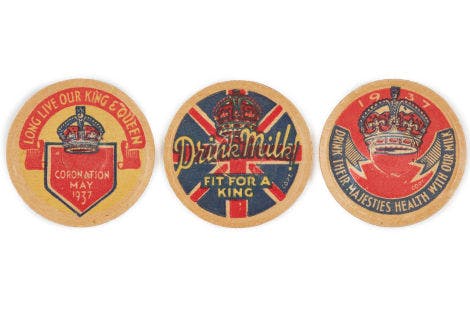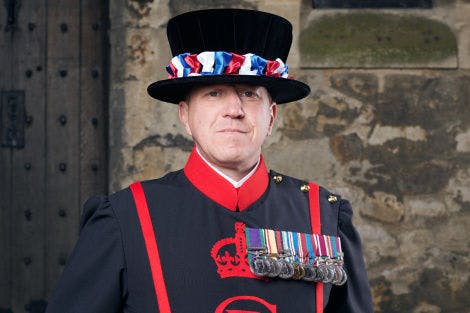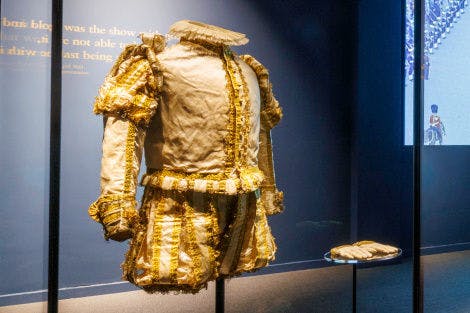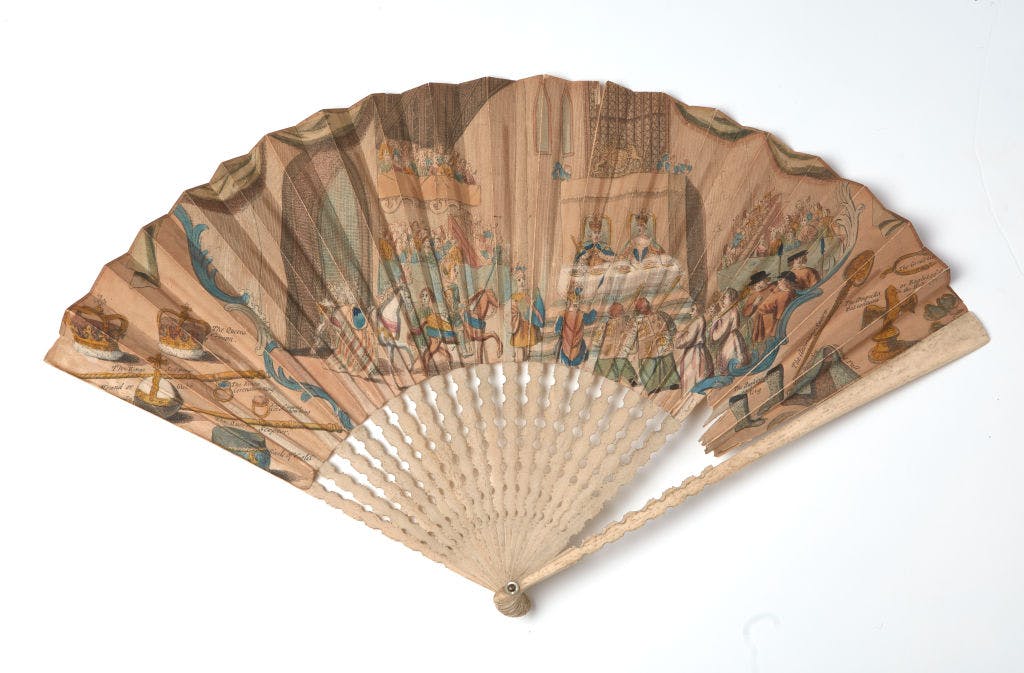Coronation Memorabilia: History and Tradition
Date: 12 May 2023
Author: Lee Prosser
Collectors of royal memorabilia have been eagerly surveying the shops and internet for the host of opportunities the Coronation of His Majesty King Charles III and Queen Camilla has given to add to their collections. Here, Historic Royal Palaces Curator Lee Prosser reflects on the long history of this fascinating aspect of royal history.
Shops and websites are full of coronation merchandise as retailers try and cash in on our enthusiasm for the coronation; special souvenir issues of the newspapers, bunting and plastic Union Flag bowler hats cater to our desire to celebrate but also to own a personal memento of a notable event.
This year the supermarkets have even been selling special coronation chipolatas, jams, and golden syrup – not necessarily something you can put in your display cabinet, but great for a special barbecue or cream tea.
Header image: Souvenir postcard issued on the occasion of the coronation of George V and Queen Mary in 1911. © Historic Royal Palaces
Coronation Medals and Memorabilia: A 17th Century Tradition
Like the coronation itself, memorabilia has a long tradition, going back to at least the 1660s, when hand-painted delftware pottery was produced for the restoration of Charles II. Not surprisingly, most are only to be found in museums these days.
More common were coronation medals, produced as keepsakes, but it wasn’t until the invention of cheap, transfer-printed pottery that royalty started to appear on cups, mugs, and plates – modestly at first, but later produced in huge abundance.
1902: Edward VII and Queen Alexandra
The popularity of the royal family meant that by the coronation of Edward VII and Queen Alexandra in 1902, the tradition of royal memorabilia had become well established, and coronations were the perfect event. These souvenirs often had special pride of place, on mantle pieces or in china cabinets.
1911: George V and Queen Mary
My own favourite memorabilia, and occupying pride of place are two character jugs from the coronation of George V and Queen Mary in 1911 depicting the monarchs. Though not expensively made, they're quite rare now, and have good eye appeal for their quirkiness. Visitors to my house are always drawn to them.
1937: Edward VIII, and George VI and Queen Elizabeth
By 1937, really beautiful designs were being produced, such as an ornate plate by Paragon, produced for the Coronation of George VI and Queen Elizabeth, showing off heraldic designs.
One coronation planned for this year of course never happened. Masses of souvenirs had been produced for the anticipated coronation of Edward VIII in May 1937. But with the King’s abdication, disaster loomed for factories overwhelmed with memorabilia. A helpful rumour went out that it would all become very rare, and it flew off the shelves. Naturally it never was.
Image: Milk bottle tops commemorating the coronation of King George VI and Queen Elizabeth. © Historic Royal Palaces


1953: Elizabeth II
The coronation of Elizabeth II was something exceptional. The young Queen was a breath of fresh air after the privations of war, and in an age of burgeoning consumerism, anything that could be branded with the royal cipher or image was; from scarves, soap and handkerchiefs to fire tongs, horse brasses, pens, hair brushes, cuff-links and more.
It seems as if nothing was immune from the grip of coronation fever. Some of it was extremely tasteless and ephemeral and probably quite rare now, but coronation mugs and plates can still be bought online or in charity shops for a reasonable price.
The upper end of the market was catered to by prestigious pottery – Wedgwood and Spode, Hammersley and Paragon, who produced high quality and quite beautiful pieces, often by notable designers. These are the examples to collect.
A good example of this sought-after pottery is a mug by Richard Guyatt, a great classic which is quite expensive to buy today, and has been reproduced and updated for the coronation of King Charles. It shows that there was a market for souvenirs even at the upper end of society. One factor is that they rarely seem to have been drunk out of or used but instead cherished as heirlooms and giving people a sense that they had participated in some way or captured a part of the magic of the coronation.
Image: Souvenir tin issued by Oxo Limited to celebrate the coronation of Queen Elizabeth II. © Historic Royal Palaces
2023: King Charles III and Queen Camilla
For the King and Queen’s coronation, things haven’t been quite so extreme. We will still see bottles of special ale, mugs and key-rings. Perhaps they won’t be treasured in quite the same way, but remember that when you bought your coronation biscuits in their special tin, you embraced an age-old tradition.
Lee Prosser
Curator of Historic Buildings
Historic Royal Palaces
More from our blog

A Year in the Life of a New Yeoman Warder
27 October 2023
By tradition, only 422 people have ever held the role of Yeoman Warder at the Tower of London. Here, Yeoman Warder Simon Towe, who joined the ranks of the Yeoman Body in November 2022, shares an eventful first year in his new life.

Royal Ceremonial Dress Collection in the Jewel House
26 June 2023
Curator Charles Farris introduces some of the amazing ceremonial dress now on display in the Jewel House exhibition.


